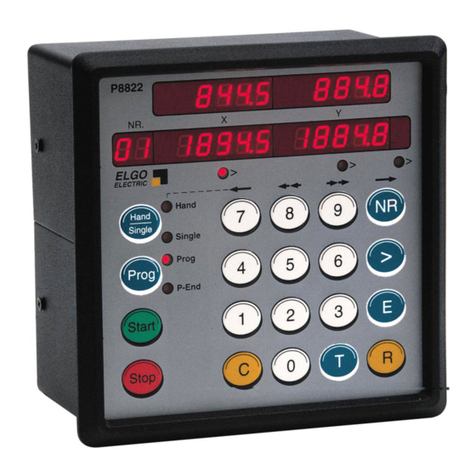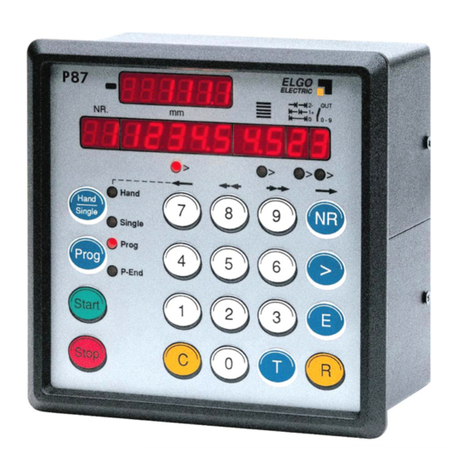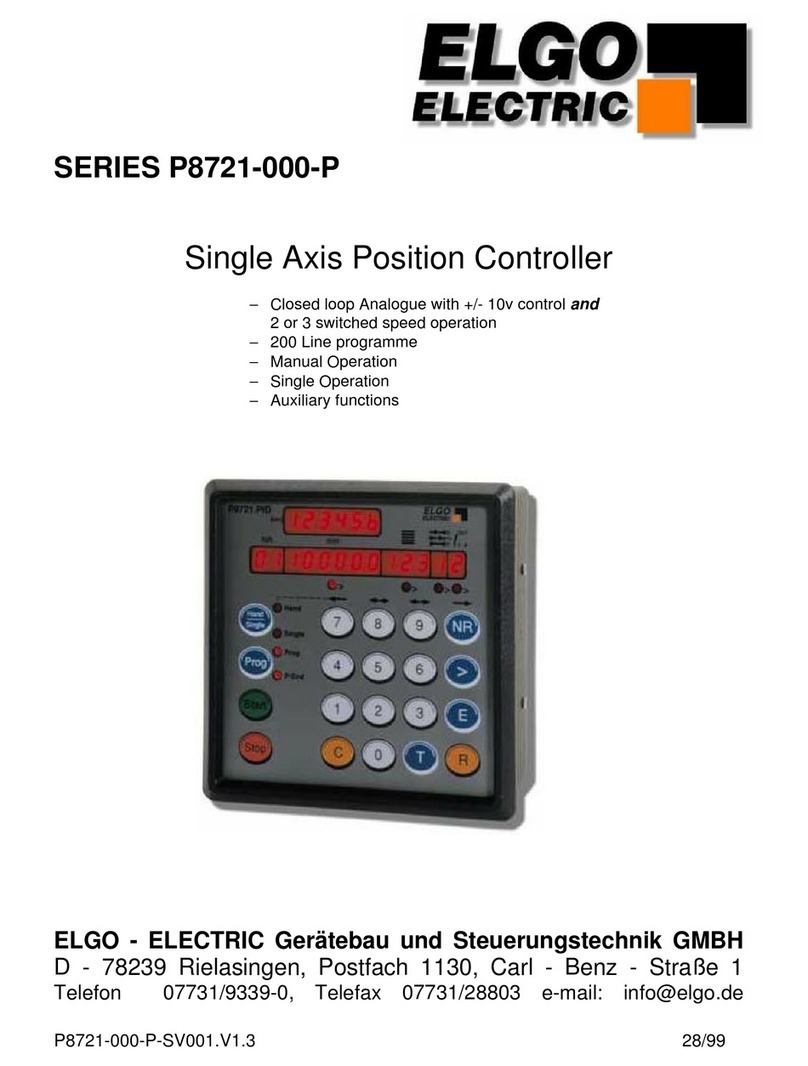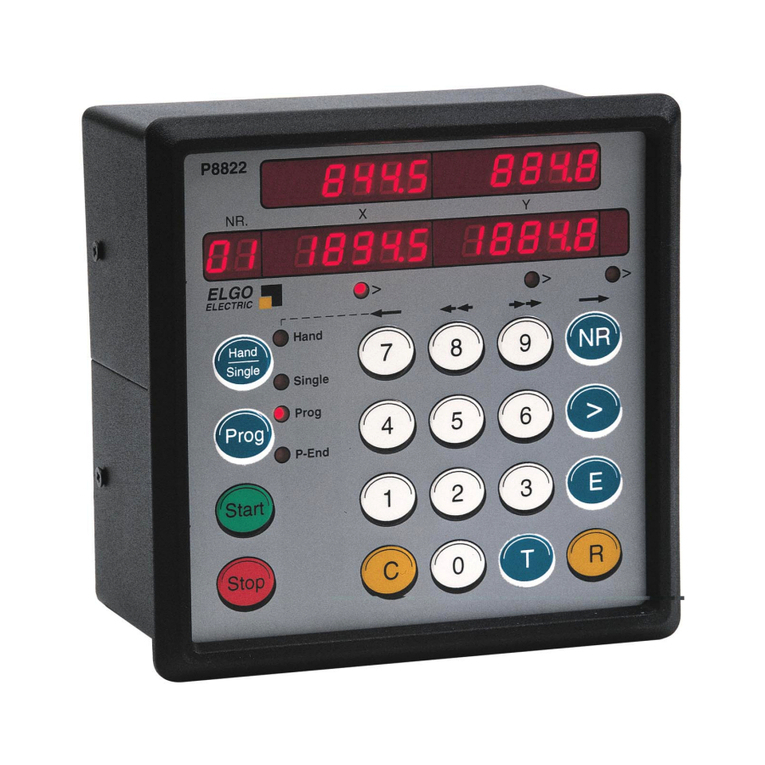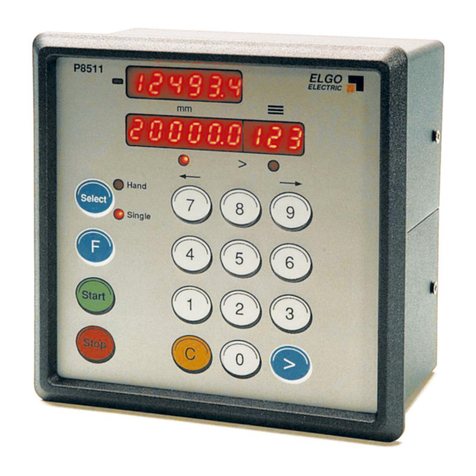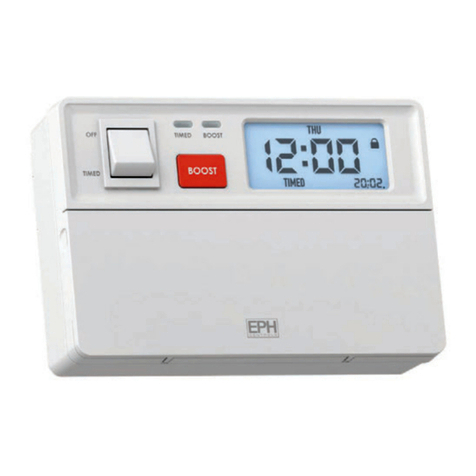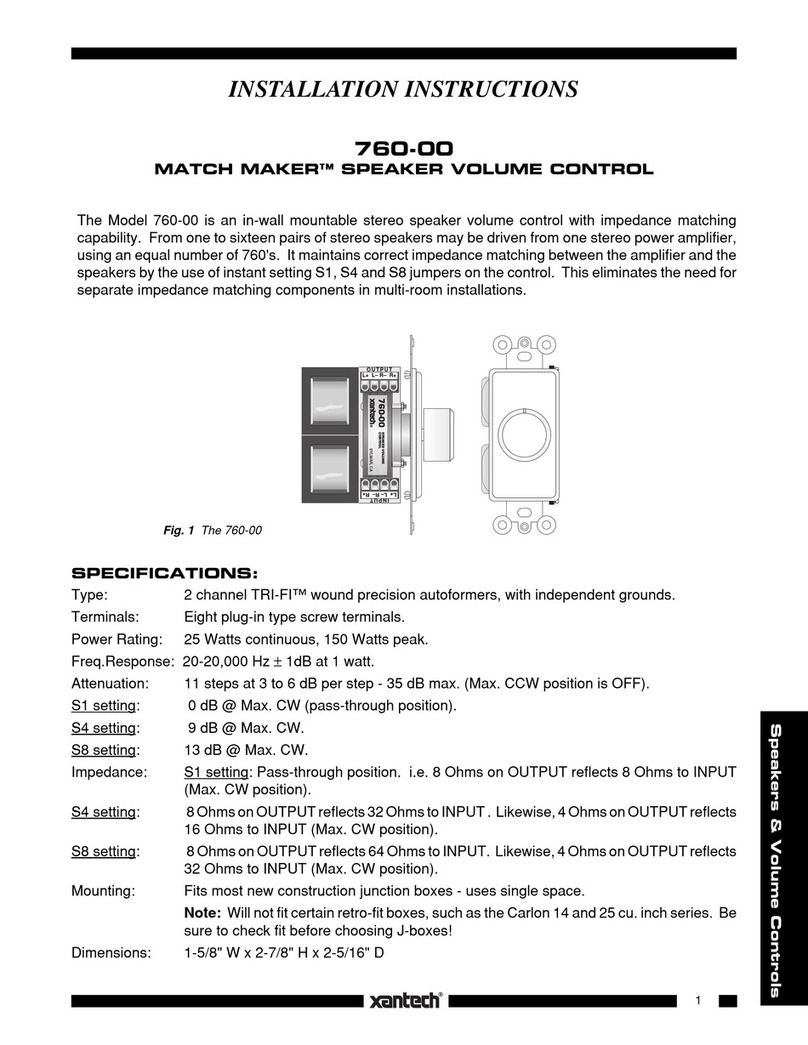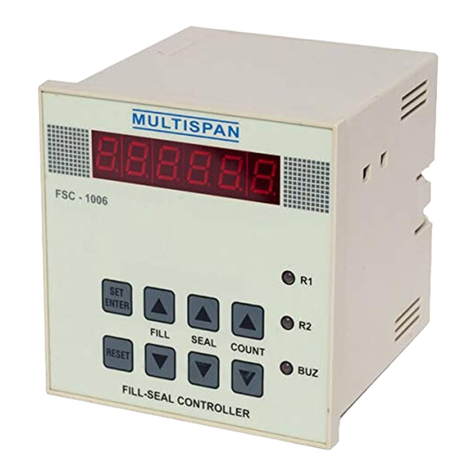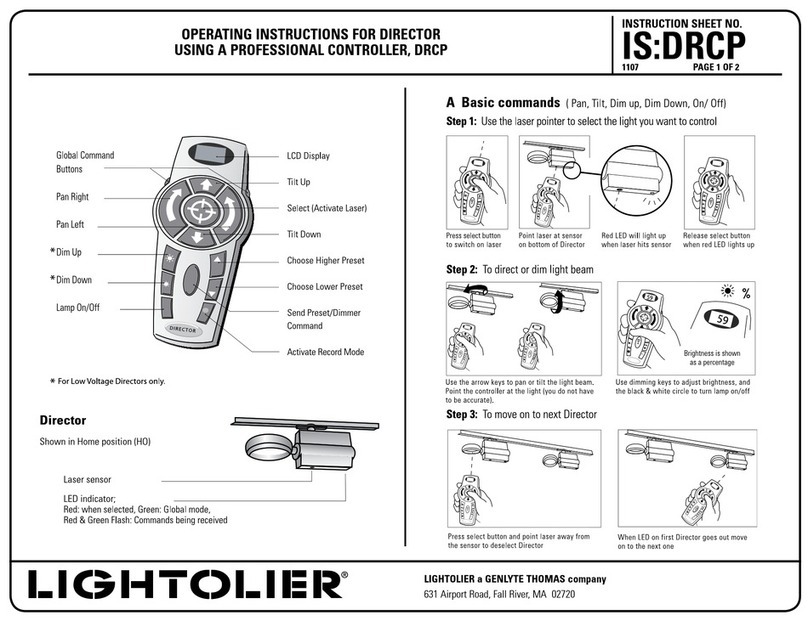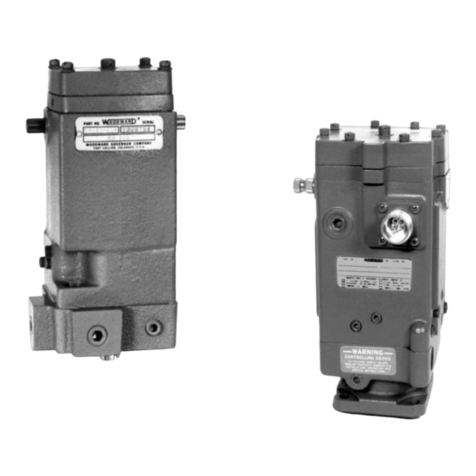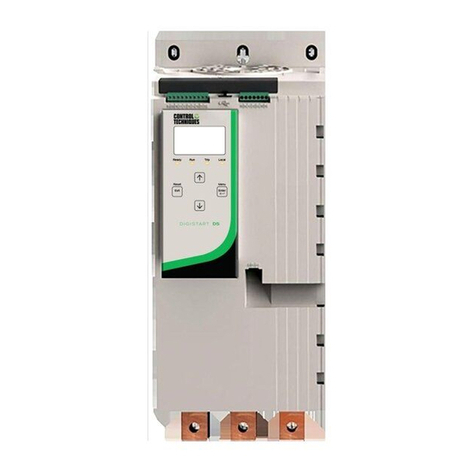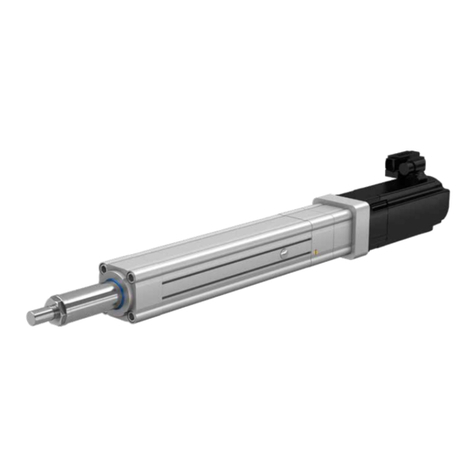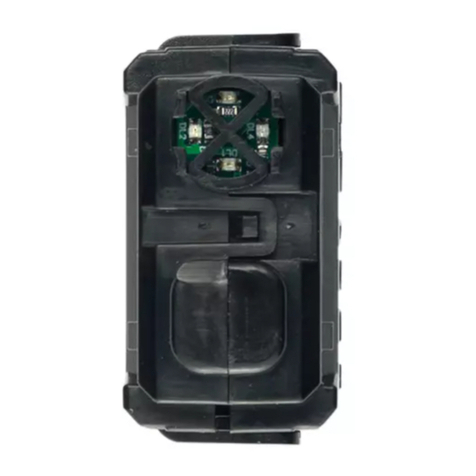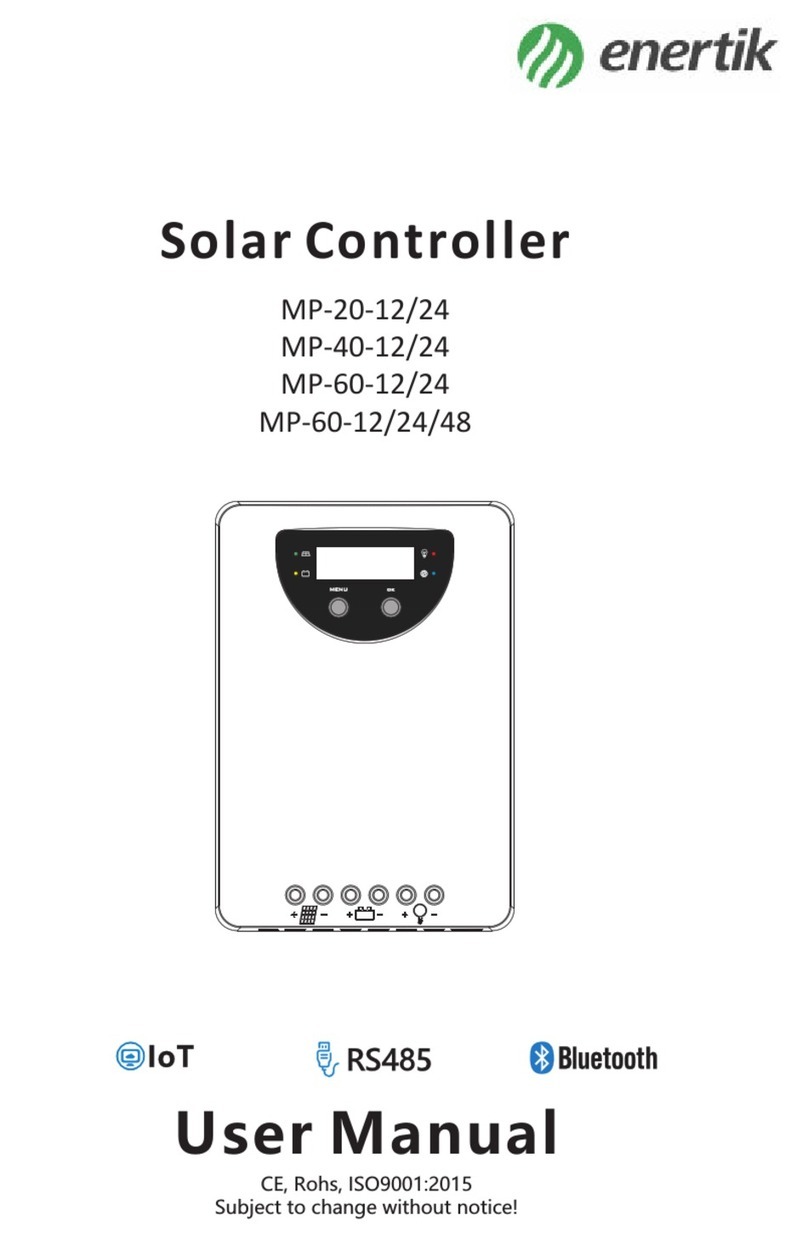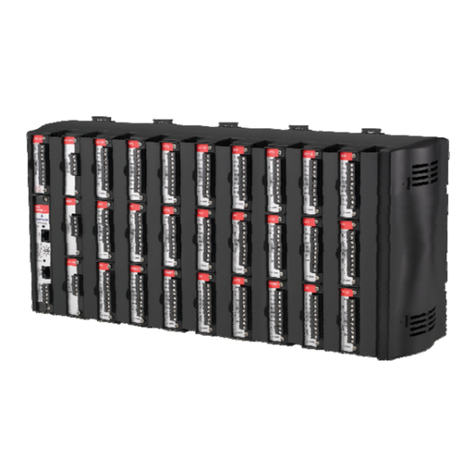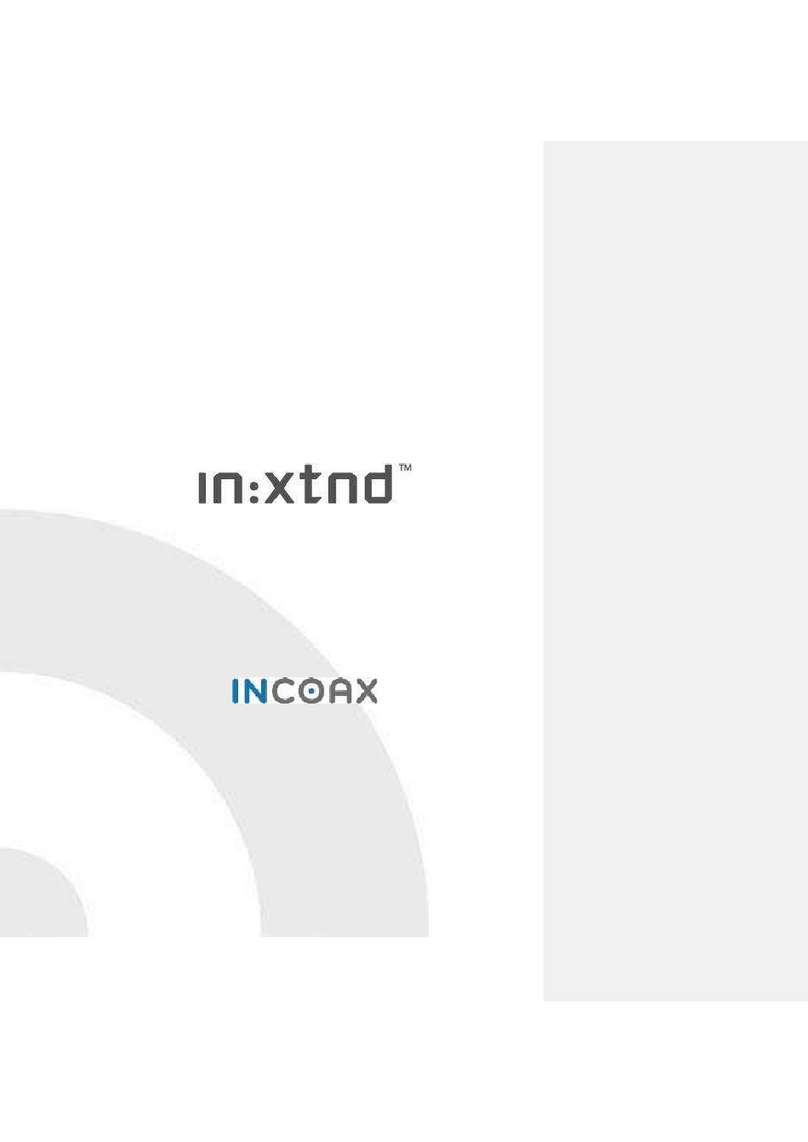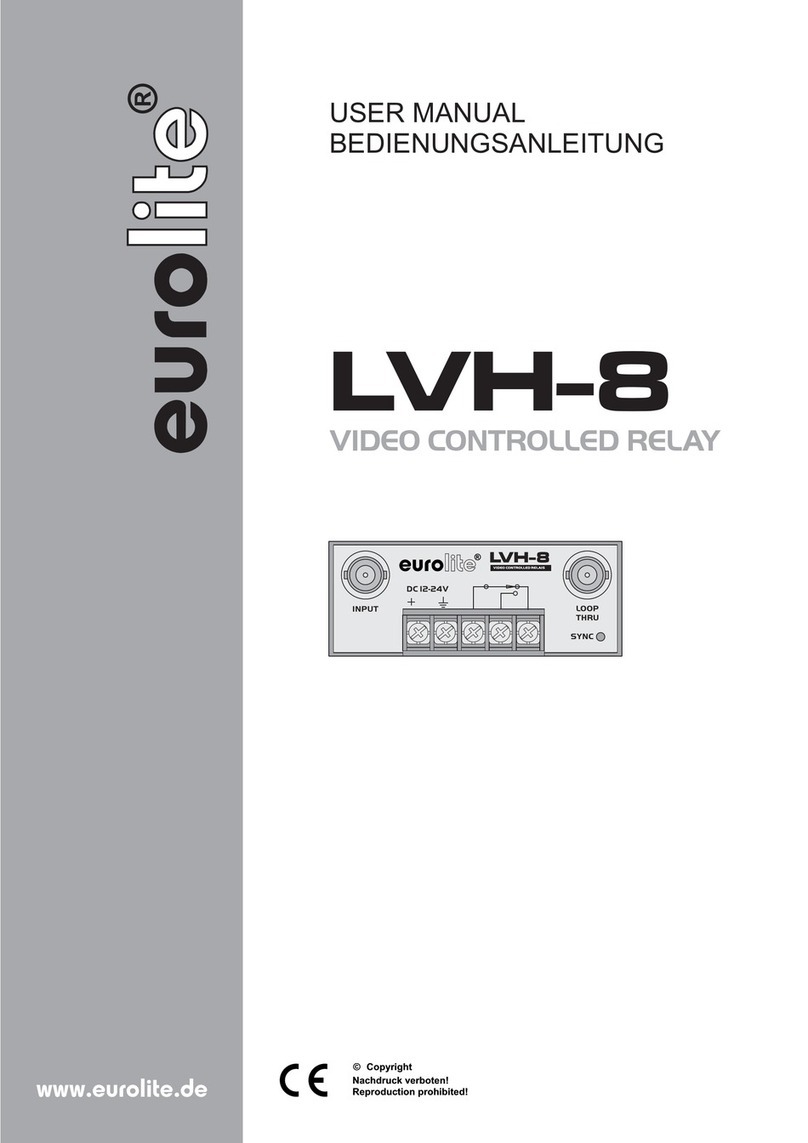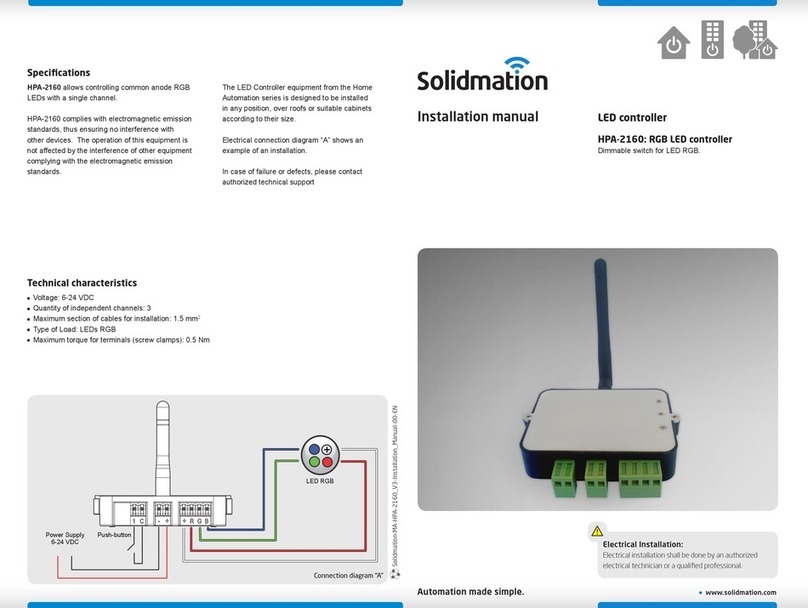ELGO Electric P8721-000-R SERIES User manual

SERIES P8721-000-R
P8721-000-R-E_22-04
Single Axis Position Controller
− integrated relay outputs
− integrated mains power supply
− 3 different speed rates
− manual operation mode
− single set operation
− 200 sets program memory

2
1. SHORT DESCRIPTION 4
2. FUNCTIONS 4
2.1 Two speed operation 4
2.2 Three speed operation 5
2.3 Setting Datum/Reference 5
2.4 Encoder Monitoring 5
2.5 Quantity Counter 6
2.6 Program counter 6
2.7 Fault Monitoring 7
3. FRONT PANEL 8
3.1 Functions of Display 8
3.2 Functions of LED’s 8
3.3 Function of the Keypad 9
4. OPERATION MODES 11
4.1 Manual mode 11
4.2 Single set operation 11
4.3 Program Operation (R8/4 = 0) 12
4.3.1 Selection of a Program Block 12
4.3.2 Input of a Program 12
4.4 Table mode (R8/4 =1) 13
4.4.1 Operation in Table mode 13
5. REGISTER INPUT 13
5.1 Unlocking Registers by Security Code 13
5.2 Setting and Changing Register Values 14
5.3 Locking of Registers 14
6. PARAMETER TABLE 15
7. DESCRIPTION OF REGISTERS 16

3
8. RELAY CONFIGURATIONS 25
9. FUNCTIONS OF INPUTS (TERMINALS ST3 AN ST4) 27
10. FUNCTIONS OF OUTPUTS TERMINALS ST5 & 6 29
11. CONNECTIONS 30
11.1 Terminal assignment 31
12. TECHNICAL SPECIFICATIONS 31
13. INSTALLATION/WIRING 32
14. ONLY FOR SERVICE 33
15. TYPE DESIGNATION 34
16. LIABILITY EXCLUSION / GUARANTEE 35

4
1. Short Description
Features of P8721
• 2 or 3 speed positioning
• absolute and incremental positioning modes
• program memory (200 sets)
• single set operation
• manual operation, slow and fast mode
• batch counter with zero-output
• pulse factor
• datum setting routines
• tool offset compensation in incremental mode
• Incremental error compensation
• backlash compensation
• tolerance window
• encoder monitoring
• max. input frequency 20 kHz
The unit is suitable for operation with any type of 2 or 3 speed bi-directional drive or any variable speed drive
with 1, 2 or 4 quadrant of control. The performance and accuracy obtained is dependent on the type of drive
chosen. The outputs for stepped speed drives are relays. These outputs can be configured in a number of ways to
suit all types of control circuits. Actual position is monitored by incremental encoder. The power supply unit is
integrated. The controller can be used to position machinery to any desired absolute position. Alternatively, the
controller can be used to feed material through a process.
Notice!
The integrated .R unit contains only 10 relays and cannot provide the Auxiliary functions.
If Auxiliary functions are required, the purchase then non-.R version, with external relays.
2. Functions
2.1 Two speed operation
NB: R1 = R2 > R3 The value in Register 1 must be the same value as R2
Creep point
Fast (and slow)
creep
Demand position
Stop Offset P 3
P 2

5
2.2 Three speed operation
NB: R1 > R2 > R3 The value in Register 1 must be larger than R2
NB: The stop offset is only effective when R8 = 1xxxxx.
2.3 Setting Datum/Reference
Datum can be set in a variety of ways. The method is selected in Register R8/3
R8 = xx0xxx Datum to R7
Closing input St 3 / 4 transfers the value set in R7
into Actual Value Display
R8 = xx1xxx Setting to Preset
Closing input St 3 / 4 transfers the Demand display
value into Actual Value Display
R8 = xx2xxx Automatic reference + (positive direction)
R8 = xx3xxx Automatic reference – (negative direction)
R8 = xx4xxx Datum with keypad alone
The value of R7 is transferred to Actual Display by
accessing R7, typing in value and then pressing E.
2.4 Encoder Monitoring
If, after positioning is activated, no Encoder pulses are received after a time set in R19 (0.1 to 9.9 sec),
positioning will be aborted and fault 01 will be displayed. Setting R19 to 0.0 sec, disables this feature.
Fast
slow
creep
Slow point P 1
Demand position
Creep point P 2
Stop Offset P 3

6
2.5 Quantity Counter
Register R18/6 sets the method of counting whether adding or subtracting
R18 = xxxxx1 Automatic subtracting
R18 = xxxxx2 Automatic adding
R18 = xxxxx3 Manual subtracting (external input signal)
R18 = xxxxx4 Manual adding (external input signal)
R18 = xxxxx5 Automatic add/subtract (Single only)
R18 = xxxxx6 Manual add/subtract (Single only)
With adding function, the counter starts from zero.
When the set quantity is reached, the quantity complete output will be pulsed.
With subtracting function, counting from preset to zero takes place. When zero
is reached, the quantity complete output will be pulsed.
With add/subtract function, subtracting will take place if a preset value is entered. On reaching zero,
adding will ensue. When the quantity counter goes from 1 to 0, a pulse output is given.
The length of this pulse is set in P11. Setting 0.0 gives a maintained output.
2.6 Program counter
The program counter will be active when R46 > 0.
R 47 will be incremented after a complete program-operation. If R47 >= R46, a message „Count“ is
shown in the actual-value-window (after program-operation) and the counting value (R47) is shown in the
Target-value-window.
Simultaneously with this message the output ST5Pin8 will be activated.
If R48 = 0 the output works “static”. If R48 > 0 the output will be reset after selected pulse-time in R48.
The message (display and output ST5Pin8 ) will be cleared after pressing any key (also when time in R48
not ran off). In R47, the counter value can be deleted respective set to a new value.
Parameter:
R46 PCC-Limit - releases when reached (Access always possible)
R47 PCC-Counter - value (Access always possible)
R48 PCC-Timer - for output-signal (Access protected by R98)

7
2.7 Fault Monitoring
When a fault occurs, it’s number flashes in Actual Value Display
Fault number 01 = Encoder
02 = End Limit minimum
03 = End Limit maximum
04 = Actual position < min software limit (R13) Hand
Target position < min software limit (R13) Single
05 = Actual position > max software limit (R14) Hand
Target position > max software limit (R14) Single
* 07 = External stop activated or wire break
*The fault message is cleared by pressing any button.
“07” also flashes if “Stop” on front panel is activated in middle of any move.
*Notice for 07: The external stop input must be linked before system can operate. Therefore, if external
n/c pushbutton is not fitted, then insert a permanent wire link.

8
3. Front panel
3.1 Functions of Display
Address Window : Shows address line of Program (or Register Nr)
Actual Position : Shows the Actual Position of the axis
Demand Position : Here you can enter the required position (or Register value)
Quantity Window : Shows how many pieces are left to be cut (or have been cut)
or how many incremental moves yet to be completed.
Abs/Incr Window : Defines Target window
0 = Absolute dimension
1 = Incremental + positive direction
2 = Incremental - negative direction
3 = Incremental from zero
4 = Incremental from zero – tool offset
3.2 Functions of LED’s
LED “Hand” : Illuminates after selecting “Single” mode by “Hand/Single” button
LED “Single” : Illuminates after selecting “Hand” mode by “Hand/Single” button
LED “Prog” : Illuminates when “Program” mode is selected.
LED “P-End” : Illuminates when program operation is complete (program end)
LED 1 - 4 : Indicate which input window is selected. Windows can be changed by button >
5
NR. mm
Prog
Start
Stop
4
Hand
Single
Prog
P-End
OUT
1 -
4
2-
1+
0
ELECTRIC
ELGO
>>>>
6
3
T
E
R
Hand
Single 89NR7
1
C
2
0
TYP P8721
()
sign symbol
demand
position
actual
position Quantity
absolute/in
cremental
selection
Select single / manual
Select programme
operation
Start positioning
Stop positioning
LED 1-4
Address number selector
Cursor
Set programme end
Selector for parameter
Clear Reset
line adress
Helping function

9
3.3 Function of the Keypad
Hand/Single
1. Alternate pressing will select “Single”.
A Demand position can be entered. Using Cursor > Button enables quantity to also be set.
2. Alternate pressing will select “Hand”.
The Buttons 7/8/9/NR can be used for manual positioning at fast and creep
speeds in both directions.
Prog Selects Program mode.
Execute the desired program by pressing “Start”.
(or Press R, to access Registers)
Start Starts positioning action
The Start Button is inhibited when programming or setting of Registers
is selected – also in Hand mode.
Stop Motion is stopped.
NR This Button is only active in Program mode. It has the following functions.
1. Start the programming action. Thereafter, only the Cursor Button > needs pressing
2. Checks existing program. Pressing “NR” repeatedly scrolls through the program.
3. Selects the required address in Table mode (see section 4.3).
5
NR. mm
Prog
Start
Stop
4
Hand
Single
Prog
P-End
OUT
1 -
4
2-
1+
0
ELECTRIC
ELGO
>>>>
6
3
T
E
R
Hand
Single 89NR7
1
C
2
0
TYP P8721
()

10
>The Cursor Button selects the Target windows sequentially.
On completion of a line, the next press of “>” will select the next Address line.
LEDs 1 – 4 indicate the selected Window.
EThis Button will :
• Set the end of program and reset the controller into operation mode.
This Button should be pressed only when the last window is selected (LED3)
• Stop the entered Register values.
• End Register setting at any point.
RSelector for entry of Register values. Only active when “Prog” selected.
TReset Button : Resets all Target windows to zero in Program mode.
CClears selected Target window value.
0 – 9 Numerical keys for data entry.
5
NR. mm
Prog
Start
Stop
4
Hand
Single
Prog
P-End
OUT
1 -
4
2-
1+
0
ELECTRIC
ELGO
>>>>
6
3
T
E
R
Hand
Single 89NR7
1
C
2
0
TYP P8721
()

11
4. Operation modes
Switch on conditions are programmable in register R33:
R33 = xxxxx 0 same conditions as at time of switch off
R33 = xxxxx 1 Single mode
R33 = xxxxx 2 Program mode
R33 = xxxxx 3 Hand mode
The Actual position is memorised. In “Hand” the target window line is switched off.
In “Prog” mode the Target windows are set to zero.
In “Single” the Demand value is set to zero.
4.1 Manual mode
Press T
Resets target windows to zero. Use the Button “Hand/Single” to select “Hand”. LED “Hand” illuminates.
Buttons 7/8/9/NR can be used to move the Axis forward and backwards at high and low speeds (whilst
the button is depressed). The remaining Buttons are inhibited in Manual mode.
The Buttons have the following functions :
• Button 7Slow Reverse
• Button 8Fast Reverse
• Button 9Fast Forwards
• Button NR Slow Forwards
If a 3 speed drive is used, the Fast and Creep speeds are used.
Physical direction of movement can be reversed by setting of Register R64.
4.2 Single set operation
In addition to Program operation, a Single complete line can be set.
The activated windows can be selected in parameter R28/2
Press Hand/Single LED “Single” is illuminated.
Use Keys 0 – 9 To enter desired position.
Press > LED under Quantity Window illuminates.
Use Keys 0 – 9To enter desired quantity.
Press > If further windows are activated courser LED move to next window
Press Start The Axis moves to required position.

12
4.3 Program Operation (R8/4 = 0)
4.3.1 Selection of a Program Block
The P8721 has a Program memory of 200 Address lines. These can be divided into several Blocks of
equal quantity of lines (see Register R41). Each Block can store a different Program, which can be
selected for operation, at will. If for example, 8 Blocks of 25 Lines is set, selecting a Block higher than 8,
will result in Block 8 being selected.
To select the required Block for operation.
Press Prog Selects Program mode
Press T Resets windows to zero
Press R The Nr (Address) Window flashes
Key in 40 40 appears in Nr Window (flashing).
Press > The previously selected Program Block is displayed in Target window
Press C Clears value to zero
Key in (e.g.) 3 3 appears in Target window
Press E Program Block 3 is called up and sequence is ended
Controller returns to Operation mode (all input windows are “0”)
Now the Block can be used with the existing program, or a new program can be entered.
4.3.2 Input of a Program
The required Program Block is selected in accordance with section 4.2.1. The Memory-block remain
selected also after power down.
Press Prog Selects Program mode
Press T Reset controller.
Press Nr “01” appears in Nr Window. LED illuminates under Target window.
Press C Clears existing value.
Use Keys 0 – 9 To enter new dimension.
Press > LED illuminates under Quantity Window.
Press C Clears existing value.
Use Keys 0 – 9 To enter required quantity.
Press > LED illuminates under Abs/Incr Window
Press C Clears existing value.
Press : 0 = Absolute Position
1= Incremental + positive direction
2= Incremental – negative direction
3 = Incremental from “zero”
4 = Incremental from “zero” – tool offset value
Now one program line is completed.
The operator can now end programming or continue to next Address line.
To end programming – Press E
To move to next line - Press >

13
4.4 Table mode (R8/4 =1)
If R8/4 is set to 1, then the controller operates in 99 selectable address Table mode.
Programming is exactly the same as in 4.2.2.
4.4.1 Operation in Table mode
An address line of the stored program can be called up and positioning effected to that setting.
Press Prog Selects Program mode
Press T Resets Controller.
Press Nr The Nr Window flashes “0”.
Key in (say) 58 “58” flashes in Nr Window.
Press > The programd values of address 58 are displayed.
Press Start The Axis executes the demanded settings.
5. Register Input
5.1 Unlocking Registers by Security Code
The values of Registers R1 to R97 can be changed after the Security Code 250565 has been entered into
Register R98. (Note that Registers R06, R07 and R40 are accessible without need for Security Code).
Accessing Registers can only take place when Controller is selected to Program mode. In Register input
mode, the decimal point is always at the correct position for the register resolution. All Registers are
entered in the Position Target window.
Use Button Eto :
a) Store Register values
b) End editing at any point.
Press Prog Controller is set to Program mode. LED “Prog” illuminates.
Press R The Nr Window flashes
Key in “98” Value 98 appears in Nr Window with “8” flashing.
Press > The Target window shows “000000” without decimal point.
Press C Clears display to zero.
Key in “250565” Display shows 250565 (The Security Code).
Press E The Controller is now set to data entry mode. All Windows are
set to zero. Decimal point is reinstated.

14
5.2 Setting and Changing Register Values
Example: The Slowdown Point of 20.0 mm needs to be entered.
Assuming that Registers have been unlocked as above :-
Press R The Nr Window flashes.
Press 1 1 (flashing) is displayed in Nr Window ie Register 01.
Press > The existing value of R01 is displayed in Target window
Decimal point is extinguished.
Press C Clears old value to zero.
Key in “200” Window shows 200 (ie 20.0 mm).
Press EThe new value is memorised. All Windows are reset to
zero and Decimal Point is reinstated.
Any Register from 1 to 97 can be selected and changed in the above manner. If sequential Registers are
to be set, Press > twice instead of E and continue editing Register by Register.
Press E on completion.
It is possible to run the Controller with Registers unlocked, e.g. having set the Stop offset Register R03,
you may now execute a “Single” move and then go back to edit R03.
5.3 Locking of Registers
Once all the values have been set, it is necessary to relock the Registers to avoid accidental changes.
There are three methods to do so.
• Select “R98” and type in (instead of security code) a “0” by the “C” button:
Type in : R – 9 – 8 - >- C – E
• Activate the “Reset” input
• Switch “power down” and shortly after “power on”

15
6. Parameter table
Register Function Adjustment-Range Default Customer
01 Slow speed distance (forward) 0.1 mm 200*
02 Creep speed distance (forward) 0.1 mm 100*
03 Correction stop (forward) 0.1 mm 0
04 Spindle compensation 0.1 mm 50
05 Retract distance 0.1 mm 500
06* Tool Width /Tool offset 0.1 mm 0
07* Datum/reference value 0.1 m 1000
08 System Register 1 See Page 17 130000
09 Position reached pulse 0.1 s 10(0=held)
10 Backlash dwell time 0.1 s 10
11 Quantity reached pulse 0.1 s 10(0=held)
12 Tolerance window 0.1 mm 0
13 Min software limit 0.1 mm 0
14 Max software limit 0.1 mm 500000
15 Software limit disable 0,1,2,3 0
17 Display brightness 0-15 10
18 System Register 2 See Page 20 000001
19 Encoder pulse monitor time 0.1 s 0
20 Decimal point 3,0,2,1 0
21 Slow speed distance (only backwards) 0.1 mm 200*
22 Creep speed distance (only backwards) 0.1 mm 100*
23 Correction stop (only backwards) 0.1 mm 0
24 Window “forced loop” 0,1mm 0
25 Home position 0,1mm 10000
28 System Register 8 See Page 22 000000
29 Time delay for drive enable 0.1 sec 10
30 Time “Program-end” 0.1 s 10
31 Closed loop inhibit time in Hand 0,1 sec 10
33 Power on mode 0,1 sec 10
34 Start delay time 0,1 sec 10
40* Program Block selection See Page 12 1
41 Number of lines in Prog Block 1 – 99 20
46* Program counter Limit 1-99 0
47* Program cycle counter 0 - 9999 0
48 Program Counter timer (pulse time) 0 - 9999 0
56 Encoder edge multiplier 1,2,4 1
64 Direction of manual buttons 0-1 0
69 Speed of automatic reference run 0-2 0
88 System Register 4 See Page 24 000000
90 Button enable in service mode 0,1,2 0
94 Inch / factor multiplier 0.0to 9.99999 100000
96 Pulse factor for encoder 100000
97 Inch / mm conversion mode 0,1,2,3 0
98 Security code 250565 0
99 Service - - 0
* Logical sequence values such as these must always be present, regardless whether
3 speed, 2 speed or 1 speed drive is used.
P1 > P2 > P3 for 3 speed drive P1 = P2 > P3 for 2 speed or 1 speed drive.
Registers R6, R7 R40, R46 and R47 can be accessed and changed without need for Security Code.
The Registers R50 to 55, 57 to 63 and 65 to 68 are for analogue output only.

16
7. Description of Registers
R01 Slow speed distance forward/reverse or forward only ( see R28/2). Distance at which the controller
switches from high speed to slow speed. The output high speed will be switched off.
R02 Creep speed distance forward/reverse or forward only ( see R28/2). Distance to demand position at
which the controller switches from slow to creep speed
R03 Stop offset distance forward/reverse or forward only ( see R28/2)
The overrun distance can be programmed to compensate for distance from the switch-off point of the motor to
standstill. For exact positioning, the overrun distance should be very small (0.0 to 0.5 mm). Therefore the
mechanical friction should be steady and the creep speed should be very slow.
During commissioning, first set R12 to zero (to eliminate Tolerance window blanking),
then set the value of R03 to 0.0 and execute a number of moves in both directions. Note the average overrun
distance and then set R03 to that value. Then set R12 to suit.
R04 Spindle compensation
To correct for screw or pinion backlash, the Demand position should be approached from one direction only. In
positive direction therefore, the Demand position will be overrun by the value of R4 and driven back at creep
speed after a time delay of R10, to the Demand position.
R05 Retract distance
There are different modes available in the P8721, selectable by Register R18/2.
If R18/2 = 0 Retract Position = Actual + R5
If R18/2 = 1 Retract Position = Value of R5
Whilst the input St3/6 is held on, the slide will move to the “Retract” position. On release of input, slide will return
to the original position. (Value 0)
When input St3/6 is activated, the slide moves to position as set in R5 but will not return to original position on
release of input. (Value 1)
R06 Tool offset compensation
This Register can be accessed without Security Code. When moving in incremental, it is often the case that the
subsequent function is a cut that removes part of the material. Thus to cut the correct preset lengths, it is
necessary to move the demanded distance plus the “Tool Offset”. This feature is active in incremental mode.
R07 Datum/reference value
The Datum value is stored in this Register. The value is used in different ways, in accordance with setting of P8/3.
Input St3/4 initiates loading. This Register can be accessed without Security Code.

17
R08 System Register 1
This Register sets the basic operating functions of the unit.
Target window
Spindle compensation
0 = no spindle compensation
1 = negative spindle compensation
2 = positive spindle compensation
3 = negative spindle compensation in range of R24
4 = positive spindle compensation in range of R24
Output Relay Configuration
0 = 3 speed operation Creep ,slow, fast
1 = 2 peed Forwards + Backwards
2 = 2 speed Run + Reverse
3 = separate outputs - fast forward, slow forward, fast rev. slow rev.
4 = Fast only in reverse direction
5 = 3 speed Binary coded
6 = 3 speed operation, Forwards + Backwards
Program Memory
0 = Sequential Program
1 = Table selection
Datum/reference
0 = Datum to R7 with external pulse by key-switch
1 = Datum to Demand position window with external key-switch
4 = Datum to R7 by key-board only
Display windows (program mode only)*
0 = All windows in use
1 = Target alone
2 = Target + Batch counter
3 = Target + Batch counter + Abs/Incr.
Type of positioning
0 = Analogue positioning
1 = Fast/slow/stop
* Display selection for single mode see R28/6 (page 21)

18
R09 Time position reached
At the end of each move, the controller gives an output, to signal “in position”. The length of this pulse is set in
R9. Setting 0.0 gives a maintained output. This output St5/1-2 is active when Actual position = Demand position
+/- Tolerance window R12
R10 Backlash dwell time
When the machine stops at the end of the overrun, it is usually desirable to have a short delay. The time is set in
this Register.
R11 Time “Quantity complete”
When the quantity counter goes from 1 to 0, a pulse output at St6/3-4 is given. The time this will be set in R11.
Setting 0.0 gives a maintained output.
R12 Tolerance window
It is possible to enter a value in Register R12 that represents an acceptable tolerance e.g. 0.1 mm. When the
Actual Position is within the Tolerance window, the Actual position displayed is made equal to the Demand
position. The actual error is not lost, as the controller knows the true position.
Example: R12 = 0.2 Therefore tolerance window is +/- 0.2mm
Display without tolerance Display with tolerance
Notice: The tolerance window “R12” should be “ZERO” at first start up!
Single set operation
Immediately after start signal, the controller checks the software limits. If the Demand position is greater or
smaller than the corresponding limit, the controller will stop and show the error message on the display. The
backlash distance in R4 is considered at the check of the Max software limit, if the backlash is activated in R8/6.
Manual operation
The movement will stop when software limits are reached. If moving at high speed, the drive will drop to creep
speed at a distance set in R1 from this limit. This prevents running into the ends of the machine. The end limit
values are modified by backlash value as set in R4, if R8/6 is selected.
Aktual Display
Target Display

19
R15 Software Limit / End Limits Selection
Software limits (R13 & R14) are active in accordance with the setting of R15/6
R13/R14 Min/Max software limits
Fault Message
Target < Limit R13 = 04
Target > Limit R14 = 05
xxxxx0Both software limits active
xxxxx1Min software limit (R13) inhibited
xxxxx2Max software limit (R14) inhibited
xxxxx3Both software limits (R13&R14) inhibited
External limit switches can be connected to the St4/3 (backwards) and at St4/4 (forwards)
xxxx0xBoth limits inputs active
xxxx1xMin limit input (St4/3) inhibited
xxxx2xMax limit input (St4/4) inhibited
xxxx3xBoth software limit inputs (St4/3 St4/4) inhibited
Notice: If these are not connected to limit switches they need to be connected Normally
closed (i.e. linked out).
R17 Display brightness
With the setting of this Parameter, the brightness of the displays can be altered.
0= dark, 15 = max brightness.

20
R18 System Register 2
This Register also sets the functions of the controller.
Target window
batch counter
0 = no batch counter
1 = automatic subtracting
2 = automatic adding
3 = manual subtracting (external input St3/7)
4 = manual adding (external input St3/7)
5 = automatic add/sub (in Single only)
6 = manual add/sub for (in Single only)
7 = automatic subtracting, STOP when “zero”
8 = manual subtracting, STOP when “zero”
Option
positioning in program mode
0 = Absolute
1 = Incremental + positive direction
2 = Incremental – negative direction
3 = Incremental from zero
4 = Incremental from zero minus “tool offset value”
positioning in single
0 = Absolute
1 = Incremental + positive direction
2 = Incremental – negative direction
3 = Incremental from zero
4 = Incremental from zero minus “tool offset value”
retract mode
0 = retract to Actual + P5 setting value =- subtracts
1 = retract to P5 setting return on deactivation
2 = retract whilst input active return on deactivation
3 = retract to Actual + P5 without return
4 = retract to P5 without return
5 = retract whilst time in R10 in positive direction, no return
6 = retract to Actual – P5 in negative direction, return on deactivated
7 = retract whilst time in R10 in negative direction, return on deactivated
8 = retract to Actual – P5 in negative direction, no return.
9 = retract whilst time in R10 in negative direction, no return.
serial link
0 = none
1 = with RS232
Table of contents
Other ELGO Electric Controllers manuals
